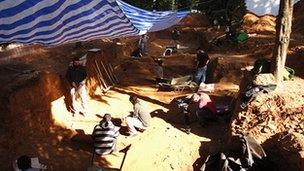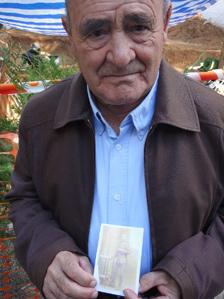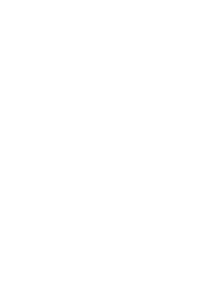Digging up Franco-era truths in Andalucia
- Published
More than 100,000 people are still missing from the civil war
On the left hand side of Cazalla cemetery the graves are arranged neatly in a wall, Spanish style.
But across the path from the engraved headstones and flower arrangements, a very different kind of grave has been discovered. The vast pit now being excavated is a burial site from Spain's civil war.
In August 1936, dozens of Republican supporters - and anyone suspected of it - were shot and flung there.
Now uncovered, their bones lie sprawled as they landed: an arm above a head, a skull face down, the soles of shoes still eerily intact on skeletons.

The graves uncovered so far are just a fraction of the total number
Luis Pobrito was five when his father was taken away by nationalists loyal to General Franco. All Luis has today is one photograph and the conviction his father was killed here.
"I just want to find him and bury him over on that side, in a proper grave," Luis says, gesturing towards the flowers.
"That's all I want. Nothing more."
Rights for victims
It is 10 years since relatives of Spain's "disappeared" uncovered the first mass burial site from the war, and broke an unwritten pact of silence over the past.
More than 150 Republican graves have been found since then - in ditches, down wells or at the edge of cemeteries. But it is just a fraction of the total.
After Emilio Silva discovered the grave of his own grandfather in northern Spain he created an association to help others, doing what he argues is the duty of the Spanish state.

Luis says he simply wants to give his father a proper burial
"We are talking about crimes of kidnap, torture, (people) killed - and it's difficult to understand that a group of relatives have to resolve the question. We are the victims," Emilio says.
His own grandfather was trying to set up a secular school in his village when he was killed.
"State intervention would show that the victims have rights, and in a democracy there should be rights for all," Emilio argues.
The government has granted close to 6m euros (£5m) for exhumations since 2006, and the budget has increased this year despite the economic crisis.
But it is estimated there are more than 2,000 unmarked graves across the country and much of the work locating and unearthing them is still done by volunteers.
A national map of grave sites, prescribed in the Historic Memory Law three years ago, has still not materialised.
"So many people disappeared during the civil war. It's a wound that's still open," explains Elena Vera, the archaeologist in charge of the Cazalla site.
More used to ancient Roman remains, she found excavating her country's traumatic, recent past deeply moving.
It is estimated that 300 men and women were buried here. The round holes in the nearby cemetery wall are thought to be the marks of gunfire, from their execution.
"I think to talk about that history, to exhume the bodies for the relatives - or at least locate their graves - that's a way of sealing the wound. We have to let people cry for those who died at last. To mourn the disappeared," Elena believes.
But in this quiet Andaluz town, the opening of the mass grave has unearthed suppressed memories too: of a bitter, divided past that no-one discussed openly here for seven decades.
"We never used to speak about the war here. But it's starting now that they've discovered the bodies," says Anna, a local woman in her 80s.
"Some people agree with it, some don't. But we never spoke about all this until now."
'Leave them be'

The excavations have stirred painful memories in Cazalla's quiet streets
Ms Vera, the archaeologist, discovered that her own uncle and great-grandmother had been "taken for a walk" during the war, and never returned.
And in the centre of Cazalla, a man claims he actually witnessed the killings.
"They brought them there in a truck, under armed guard," Carmelo Guillen recalls. Now 83, he lived near the cemetery as a child.
"They shot them, then dragged them like dogs, threw them in the hole and just shovelled earth on top," he says, gesturing with his walking stick.
It is no wonder that some people are wary of digging too deep, even now.
"It should be left in the past," insists a local woman named Luisa, chatting on the wall by the church.
"Nothing can be fixed now, we can't bring the dead back. We should leave them be," she says forcefully, then turns away.
But it is an unconvincing argument for relatives of the missing when those who died fighting for Franco in Cazalla were buried in individual plots in the church graveyard, beneath a huge stone cross engraved with their names.
Now, 74 years later, there are still more than 100,000 people missing from the losing side in Spain's civil war, scattered in unmarked graves across the country.
Many of the relatives now searching for their remains are already in their 80s. And the process - so late to start - is painstakingly slow.
"It's hard to tell the relatives they have to wait," says Emilio Silva. "In this past decade, a lot of people have died waiting for us."
- Published4 September 2010